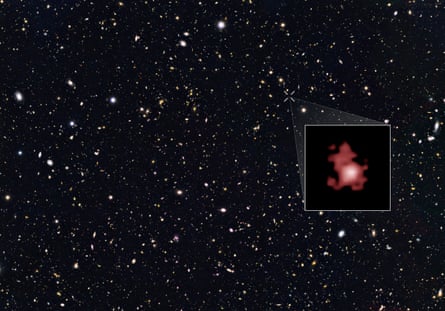Astronomers have detected the oldest black hole ever observed, dating back more than 13 billion years to the dawn of the universe.
The observations, by the James Webb Space Telescope (JWST), show that it is 440 m years after the big bang in the heart of a galaxy. At about a million times the mass of the sun, it is surprisingly large for a baby black hole, raising the question of how it got so big so quickly.
Prof Roberto Maiolino, an astrophysicist at the University of Cambridge, who led the observations, said: “The surprise is that it is so very massive. It was the most unexpected thing.”
The observations, published on the preprint website Arxiv, do not take a direct image, which is invisible because no light can escape its grasp. But astronomers have detected telltale signs of its accretion disk, the halo of gas and dust rapidly spinning around the cosmic sinkhole.
Astronomers believe the earliest black holes can help unlock a puzzle of how their giant counterparts at the center of galaxies like the Milky Way grew to billions of times the mass of the sun. Until recently, it was assumed that they simply snowballed over nearly 14 billion years, gradually growing through mergers and eating up stars and other objects. But this snowball scenario cannot fully account for the epic proportions of present-day supermassive black holes.
The latest observations, of the galaxy called GN-z11, push the origin of this mystery back to black holes’ infancy and suggest that they were either born large or ballooned extremely rapidly early on.

“Understanding where the black holes came from in the first place has always been a puzzle, but that puzzle now seems to be deepening,” said Prof Andrew Pontzen, a cosmologist at University College London, who was not involved in the research. “These results, which use the power of JWST to look back through time, suggest that some black holes instead grew at a tremendous rate in the young universe, much faster than we expected.”
One explanation, known as the heavy seeds scenario, is that an early generation of black holes was born from the direct collapse of large gas clouds, rather than from burnt-out stars that collapsed under their own gravity at the end of their lives. Another possibility is that compact stars and black holes merged very quickly in the early universe.
A third, more speculative, hypothesis is the existence of so-called primordial black holes that arose during cosmic inflation, the period of faster-than-light expansion of the universe that occurred a fraction of a second after the big bang happened.
This would turn on its head the supposed order of play, in which galaxies came first and then black holes began to grow inside them. Primordial black holes would effectively be woven into the fabric of the cosmos from the beginning.
“If this were true, it would have profound implications for the opening fraction of a second of our universe,” Pontzen said. “Either way, the story of how black holes and galaxies grew up together is a compelling one that we’re only just beginning to piece together.”
The findings are the latest in a series of astonishing discoveries by Nasa’s space observatory two years after its introduction. JWST is about 100 times more sensitive than previous telescopes, such as Hubble, at detecting infrared light, the part of the spectrum used to see the most distant objects. “This is essentially equivalent to upgrading Galileo’s telescope to modern telescope. That’s 400 years of discoveries possibly compressed into the time span of JWST operations,” Maiolino said.
He said that before the launch of the telescope there was a possibility that a new window would open after “a tedious expansion of what we know”. “That’s not what we’re seeing,” Maiolino said. “The universe has been quite generous. We really find things we didn’t expect.”
What is a black hole?
Black holes are some of the universe’s strangest and most eerie objects. They have such intense gravity that neither matter nor light can escape their grip. A black hole’s threshold is tracked by its event horizon, the point of no return. Anything that strays across this boundary is gone forever.

They are challenging to study because they are fundamentally invisible, but applying the laws of physics offers some bizarre insights. When approaching a black hole, the gravitational gradient can be so extreme that objects will be stretched in a process known as spaghettification. At the event horizon, gravity is so fierce that light is bent in a perfect loop around the black hole, meaning that if you were standing there, you would be able to see the back of your own head.
What lies beyond the event horizon is unknown. Einstein’s theory of general relativity suggests that at the center of a black hole, density would become infinite, creating a gravitational singularity. This break in space-time would have no “where” or “when” and would sit outside the realm of the conventional laws of physics. But it is not clear whether such singularities actually exist.
Black holes come in a variety of sizes. Stellar black holes, formed from the remnants of massive stars, can be up to 20 times more massive than our Sun. Supermassive black holes, such as Sagittarius A* at the center of the Milky Way, can have masses equivalent to millions or billions of suns and play a crucial role in galactic evolution.
Astronomers have made significant progress in observations of black holes in the past decade, with the first image of one’s halo captured by the Event Horizon telescope in 2019, and observations of cataclysmic black hole mergers by detecting gravitational waves sent rippling through space-time. The latest observations, and even more distant James Webb targets, will begin to piece together the origins of these enigmatic objects.



